Muslim women lawyers aim to reconcile traditional beliefs with secular society
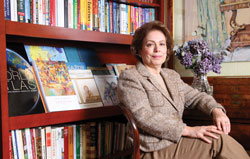
Azizah al-Hibri, professor emeritus at the University of Richmond School of Law and founder of Karamah: Muslim Women Lawyers for Human Rights. Photo by Stacy Zarin Goldberg.
On a sweltering day in mid-July, Azizah al-Hibri, founder and chair of Karamah: Muslim Women Lawyers for Human Rights, presided over the graduation ceremony for the group’s 2012 Law and Leadership Summer Program. It was a festive occasion, held in the elegant drawing room of Karamah’s offices in Washington, D.C., housed in a building that once was the French ambassador’s residence.
After exchanging booming Islamic greetings with the 20 graduates, al-Hibri smiled. “I like your voices!” she said. “That’s assertive. The first day I could hardly hear you!”
As professor emeritus at the University of Richmond School of Law in Virginia, al-Hibri is used to encouraging her students to speak up. But for the participants in the Karamah program, there is a religious imperative, as well. “Islam says that women should speak emphatically so that they should not be seen as weak and vulnerable,” al-Hibri says.
In various Muslim countries Shariah, or Islamic law, has been cited to justify restrictions on women’s freedom of movement and ability to work, get an education, manage their finances, hold elective office and even—in the case of Saudi Arabia—drive a car. But a growing number of scholars, many of them women, argue that when it is properly understood, Islam not only allows but demands that women be full, active and even noisy participants in the world.
As change moves fitfully through the Muslim world, a more assertive role for women in that world may be an idea whose time has come. In 2012, the Gallup Center for Muslim Studies reported on a survey conducted in six Arab Spring nations: Bahrain, Egypt, Libya, Syria, Tunisia and Yemen. After the Arab Uprisings: Women on Rights, Religion and Rebuilding reports that majorities of both men and women in those countries support equal legal rights for both genders, support equal access to education, and think women should be able to hold any job they are qualified for.
But most of the respondents in five of those countries (Bahrain was not surveyed on this question)—both men and women—also agreed that any new government measures should be based at least partly on Islamic law.
If there is to be a new model for women in the Muslim world, it already may exist in the United States, al-Hibri says. “We have a culture which is ideal Islamically in the sense that it is very consistent with our values of justice, equality, treating each other well, and the right of women to work and to be educated,” she says.
And perhaps no group of women is better suited to the model America offers than those who are also Muslim and lawyers. While Muslim women were late starters in the U.S. legal profession, in recent decades many have surged to leadership positions in both the profession and in their communities, founding Islamic bar associations and civil rights advocacy groups. They have, as al-Hibri might say, “spoken emphatically” for the rights of Muslim women but also in the interest of Muslim communities still experiencing the blowback from the Sept. 11 terrorist attacks.
These trailblazers sometimes must strike a delicate balance between those various priorities, which do not always easily mesh. Even the personal decision on whether to wear an Islamic headscarf, or hijab, can be fraught with complications, as Muslims disagree on whether it is mandated by the religion or even desirable, while some non-Muslims may view it as a sign of religious or political separatism, if not extremism.
“These days it can be a little tricky being a Muslim,” says Safia Hussain, a New York City-based attorney for the Asbahi Law Group in Chicago who represents community organizations, religious groups and other nonprofit entities. She is a past president of the Muslim Bar Association of New York.
For the most part, these women are taking the lead on their own initiative, says Sahar F. Aziz, an associate professor of law at Texas Wesleyan School of Law in Fort Worth. Rather than being urged forward by Muslim communities, she says, “it’s us feeling compelled to do something or say something and going on our own, solo.”
The leadership of most of the Muslim organizations that already existed before the 9/11 terrorist attacks—Aziz refers to them as “legacy groups”—remain dominated by men. As a result, many of the Muslim women entering the legal profession in recent years “decide their efforts and skills are most productively spent starting new organizations where they can focus on substantive work rather than fight internal gender battles,” she says. Aziz, for instance, is president of the Egyptian American Rule of Law Association in Washington, D.C., which provides assistance to the legal reform community in Egypt.
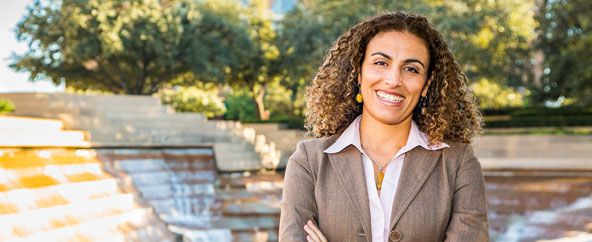
Sahar Aziz, associate professor at Texas Wesleyan School of Law. Photo by Terri Glanger.
HISTORICAL PRECEDENTS
These developments are no surprise to Engy Abdelkader of Howell, N.J., the vice president of Karamah, and the co-founder and first president of the New Jersey Muslim Lawyers Association. She currently is a vice-chair of the Coordinating Committee on National Security and Civil Liberties in the ABA Section of Individual Rights and Responsibilities.
Abdelkader points out that strong female leaders have played an important role in Islamic history since the religion was founded in the 7th century. The prophet Muhammad, Islam’s founder, himself was surrounded by powerful, active women—including his first wife, Khadija bint Khuwaylid, a wealthy businesswoman 15 years his senior. Another of his wives was Aisha bint Abu Bakr, a scholar, jurist and political leader who also led an army into battle. And Nusayba Umme Amara, the first Muslim female warrior, who, while carrying water to her husband and sons fighting alongside Muhammad, saw the prophet in danger and picked up a sword and started swinging; she went on to fight in other battles.
Despite such powerful female role models in its earliest history, Islam today is widely associated with the oppression of women. Al-Hibri, however, is among the scholars who reject that oppression as an innate characteristic of Islam. Instead, she argues that, over time, patriarchal tribal and cultural practices that actually contradict Muhammad’s teachings seeped into various schools of Islamic jurisprudence.
She says, for instance, that the practice of stoning women to death for adultery that is prevalent in some Muslim countries appears nowhere in the Quran, where the maximum punishment for adultery for both men and women is 100 lashes. Moreover, the standard of proof of adultery under the Quran is impossibly high, requiring four witnesses to the act of penetration. Punishment may only be imposed if the accused confesses; and even then, there are multiple opportunities for the accused to retract his or her confession. Al-Hibri also cautions that the prescribed punishment of 100 lashes should not be taken at face value without careful jurisprudential analysis.
Al-Hibri recalls an encounter with an Islamist parliamentarian in a Middle Eastern country who opposed women’s right to vote. “It is against what we believe,” the man said.
But al-Hibri pointed out that the Quran itself portrays women pledging fealty to Muhammad—effectively voting for the prophet. The man then smiled and said, “Well, it is not our religion, but our culture.”
“Well, do me a favor,” said al-Hibri. “When you go on TV denying women the right to vote, tell these women you are denying them because of your cultural tribal values and not your religion.”
“That’s the issue again and again,” says al-Hibri. “Instead of saying the issue is cultural, they say it is religion. Muslims are bound by their religion, but they can change their culture.”
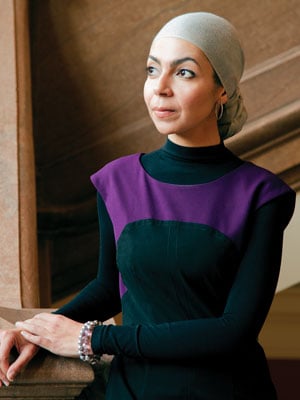
Engy Abdelkader, co-founder of the New Jersey Muslim Lawyers Association. Photo by Len Irish.
A NEW JURISPRUDENCE
The chief mission of Karamah is to develop new Islamic jurisprudence from a women’s and human rights perspective, looking with fresh eyes at Islamic religious texts and traditions, re-examining passages and translations, and researching the historical context in which they originated to uncover a faith stripped of patriarchy. Karamah was founded in 1993 by al-Hibri, who was concerned by what she viewed as a tendency of some Western feminists to blame Islam for violations of women’s rights in Muslim countries.
She also worried that efforts to raise women’s status in the Muslim world might be resisted by women themselves if they thought those changes would conflict with their faith. But, she reasoned, these same women would be more likely to support international standards for women’s rights if they better understood their rights under Islam. This, however, would require the development of new Islamic jurisprudence and the development of a network of jurists trained to apply these new ideas.
In addition to its headquarters in Washington, D.C., Karamah has offices in Maryland and Virginia. It is planning to open an office in Brussels and has organized a steering committee in North Africa. It conducts training workshops in the United States, Europe, North Africa, and a number of countries in the Persian Gulf and South Asia. Most recently, it conducted workshops on domestic violence in Washington and the Maldives.
An example of how this new jurisprudence is developed was seen last July during the final class given by al-Hibri at Karamah’s 2012 Law and Leadership Summer Program. Since 2003, Karamah’s program has brought selected women to Washington for a three-week educational program in Islamic law, U.S. family law, conflict resolution, and management and leadership skills. The goal is to create a network of Muslim women with the skills to promote rights at the grassroots level. Some of the graduates of the program included a college student who founded a nonprofit organization that provides counseling and support for young Muslim couples; a blogger from Qatar; a recent high school graduate from Virginia who plans to work for women’s rights in her native Afghanistan; the host of a Washington-area television show; and a doctor, a banker and a businesswoman from Kenya.
Just hours before the graduation ceremony, the participants sat in a classroom at the George Washington University Law School listening spellbound to al-Hibri as she tackled a troubling passage in the Quran that has been cited by some schools of Islamic jurisprudence to justify domestic violence: “As to those women on whose part you fear disloyalty and ill conduct, admonish them first, next refuse to share their beds, and last hit them.”
Al-Hibri questioned what the term hit actually means in this passage. She explained that Quranic words often have special meanings, and that there is a rule in Islam that says whenever you don’t understand something in the Quran, you have to go to other parts of the holy book to help explain it.
As an example, she turned to a story in the Quran about the biblical Job, who in a fit of anger vowed to hit his wife 100 times. “But God found it unfitting for a prophet to hit his wife or violate an oath,” said al-Hibri. “He instructed Job: ‘So take in thy hand a little grass and strike therewith and break not thy oath.’ ”
Al-Hibri interprets the original passage as a restraint, not a vindication, of male violence against women. In a time when most men took the right to beat their wives for granted, Muhammad directed them to first complain, then withdraw, then symbolically strike the wife—a sixth century equivalent of today’s anger management techniques.
She finds support for this interpretation in the life of the prophet himself, who, according to his contemporaries, never hit his wives or even raised his voice to them, and who told his male followers, “The best of you is the one who treats his wife the best.” Al-Hibri says her analysis gets very little pushback from even conservative Muslims because she bases it on fundamental principles of Islam.
But if there is a growing hunger among Muslim women for a fresh analysis that would reconcile modern concepts of human rights with their Islamic faith, there also is still no easy answer to the question of which interpretation of Shariah will prevail in the long run.
“Forcing the public to choose between international standards and their own religious beliefs and cultural traditions will create an insurmountable obstacle to the rise of women,” states The Arab Human Development Report 2005: Towards the Rise of Women in the Arab World. There is no alternative, the report concludes, to efforts to develop new, independent jurisprudence that, “released from the grip of religious institutions and personages,” could reconcile international standards for women’s rights with the Islamic faith.
“Independent interpretation must become the right and duty of every qualified Muslim, woman or man, who has the capacity to engage in the study of her or his religion,” the report states.
A desire to undertake that kind of independent approach to studying Islamic texts and history appears to be very nearly a shared rite of passage for many of the female lawyers who increasingly are taking on leadership roles in Muslim-American communities.
Amina Saeed, a co-founder and president of the Muslim Bar Association of Chicago and an estate planning attorney in suburban Lisle, says she started studying Islam independently with a group of other Muslim students in college. It was shortly after the first Gulf War in 1991, and for the first time, she was hearing ethnic slurs against Muslims on campus and elsewhere. At the same time, she learned that some Muslims were upset that she, a woman, had been elected president of her university’s Muslim students’ association.
Her studies showed that “I did not have to blindly accept what I was told about Islam, be it my parents or a world-renowned scholar,” she says. Moreover, learning about the great female leaders in Islam’s history inspired her. “Why should I achieve anything less?” she thought.
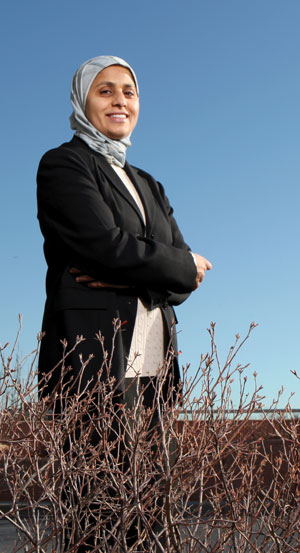
Amina Saeed, president of the Muslim Bar Association of Chicago. Photo by Katrina Wittkamp.
FIGHTING TRADITION
But when Saeed announced her intention to study law, her parents were dismayed.
That was hardly surprising, Saeed acknowledges, because in general, Muslim-Americans were slow to embrace the law as a profession. First-generation immigrants often were suspicious of the law and lawyers, who they viewed as functionaries of the government. “In the countries that they came from, anything associated with government was looked on with suspicion,” she says.
Traditional parents were particularly apprehensive about daughters entering the legal profession, even though Muslim-American women have one of the highest education levels of any group in the United States, according to Muslim Americans: A National Portrait, published in 2009 by Gallup. The study found that 29 percent of all American women hold bachelor’s degrees or higher. The two groups with the highest rates of college degrees were Jewish-American women at 58 percent, followed by Muslim-American women at 42 percent.
But within the Muslim community, there was a strong preference for daughters to enter the medical profession. Saeed remembers that her own father, a religiously conservative imam, once told her that the only respectable career for a woman was that of a physician.
“Look at the difference between those roles,” says Mais Abbas Abousy, an attorney-adviser with the Commercial Law Development Program in the Office of General Counsel at the U.S. Department of Commerce. “As a dentist or doctor, you’re in an office, you see your patients, you don’t have work afterward, you’re not a representative of the community,” she says. “You don’t meddle in other people’s business, you don’t negotiate, you don’t get involved in commercial transactions. As a lawyer, you’re front and center.”
Abousy says that her father, who had experienced political turmoil in his native Iraq, warned her: “Do not be the head of the arrow. Be in the back.” But that approach wasn’t in Abousy’s portfolio. “Ever since I was 6 years old in Baghdad, my mom said I’d stand on the top of a ladder and start arguing for no apparent reason,” she says. But when she grew older and told her parents, both prominent dentists, that she wanted to be a lawyer, they tried to dissuade her. “There were disagreements in the house,” she says, but in the end her father told her, “As long as your grades are good and you have a road, I’ll support you.”
By then the family was living in the United States. And her father, like many recent immigrants, was gaining an appreciation for the role of law in American society, realizing, for instance, that “a doctor could not survive without an attorney to help him with his medical practice, whether it be setting up his employment handbook or their malpractice insurance or establishing a will or doing their taxes,” Abousy says.
But it took the traumatic events of Sept. 11, 2001, for the Muslim community to recognize the important role lawyers can play in American society. Suddenly, Muslims across the United States were facing intense scrutiny and suspicion from both law enforcement and the larger society. “What we were seeing was a real void in the community in terms of understanding their legal rights,” says Farhana Khera, the president and executive director of Muslim Advocates. “There was also a void in terms of an effective advocacy voice for the community.”
Khera, a former counsel to the U.S. Senate Judiciary Committee, founded Muslim Advocates in 2005 to provide legal and policy expertise on issues relating to the civil rights of the Muslim-American community. The San Francisco-based group is a companion to the National Association of Muslim Lawyers.
But cobbling together America’s diverse Muslim community for a unified response to issues facing it is a challenge.
According to the Gallup Center for Muslim Studies, American Muslims rank as the most racially diverse of any religious group in the United States. While most follow either the Sunni or Shia sects, there is no centralized authority for either group, and some 2,100 mosques in the United States operate more or less independently. A 2011 Gallup survey found no advocacy group that a majority of American Muslims say speaks for them. Only 12 percent of respondents identified with the top-rated group, the Council on American-Islamic Relations.
It was natural for lawyers to step into the breach, Abdelkader says. “Our oral and written skills, combined with the ability to analyze problems and come up with solutions, make us natural leaders, especially when our communities are confronted with such massive issues such as human rights violations,” she says.
But with few older lawyers to turn to, Muslim communities had no choice but to seek out some young, newly minted lawyers. Saeed was a 30-year-old appellate attorney with the Office of the Cook County Public Guardian in Chicago who had lost a cousin in the 9/11 attack on the World Trade Center when she was tapped to become the first female director of the Council of Islamic Organizations of Greater Chicago, a federation of more than 50 Islamic mosques, schools and community service groups. She set about developing relationships with interfaith groups, government and the media. “We wanted to let the world know the terrorists were not who we are,” she says.
Even law students joined the effort. Shirin Sinnar was one of a handful of Muslim law students who joined with one Muslim lawyer to found the Bay Area Association of Muslim Lawyers. At that time, says Sinnar, who is now a professor at Stanford Law School, “in the Muslim community there were many more law students than lawyers.”
One of Sinnar’s most vivid memories is giving a “know your rights” presentation with three other young female lawyers to a very religiously conservative mosque in Stockton, Calif., in 2005. With FBI vehicles circling outside, the four young women faced a mosque packed with more than 100 men, mostly migrants from northwestern Pakistan. “It was a very surreal experience looking out at the audience,” she says. “We didn’t have that much in common, yet they really looked to us for guidance. We left thinking that we hoped we imparted information about the community’s rights, but also hoped that they would get a sense of the potential to educate their daughters.”
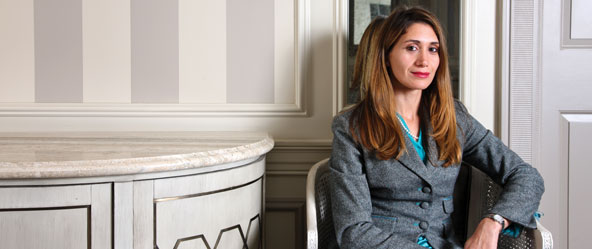
Mais Abbas Abousy, attorney-adviser in the Office of General Counsel at the U.S. Department of Commerce. Photo by Stacy Zarin Goldberg.
POINT OF CONTROVERSY
Perhaps nothing more dramatically illustrates the conflicts that female Muslim lawyers are navigating than their choices about whether to wear a simple cloth garment: the hijab, or headscarf. The hijab is fraught with meaning in almost every society with a significant Muslim population, and those controversies play out in many different ways—often reflected in government policies or cultural expectations. In Iran and Saudi Arabia, for instance, women can be arrested for failing to wear a headscarf or to cover enough of their hair. In France, on the other hand, the hijab is banned from schools and government facilities, along with Sikh turbans and Jewish yarmulkes. The only thing that seems clear is that the hijab is viewed widely as a symbol of Islam.
Female Muslim lawyers in the United States who choose to wear the hijab say they are not immune from these conflicting reactions. But they add that wearing the hijab also can work to their advantage.
“I wear it because I believe my faith prescribes it, and it’s part of being modest,” says Abdelkader. “It’s a way of having people’s attention focus on my actions and accomplishments and not on my physical attributes.”
But wearing the hijab also provides a means of engaging both Muslim and non-Muslim communities, Abdelkader says. “It allows me to not only identify myself outwardly as a Muslim, but it enables me to challenge stereotypes and misconceptions about Muslim women and Islam,” she says. She believes that if Muslims and non-Muslims encounter a well-educated American professional like herself whose hijab identifies her as a Muslim, it might challenge preconceived or traditional ideas about a “proper” Muslim woman’s roles and capabilities.
Saeed says she wore a hijab from the time she started practicing law in 1996. But as she walked into the court, people often mistook her for a translator—sometimes even after she identified herself. “It made it more nerve-wracking because I felt I had to perform better than anyone else just to be considered an equal,” she says. “But I honestly believe that that experience made me a better lawyer.”
But the hijab also has made her the target of discrimination, Saeed says. Last February, when she flew to Dallas for a family weekend with her husband and three children, she was singled out for extra security checks on both the outgoing and return flights. While she was waiting in line for the return flight, a security guard pointed at her and shouted “Scarf!” The family is now planning a trip to Yellowstone National Park. “I told my husband, I don’t care if we have to drive 25 hours, I’m not ready to go through that emotional humiliation again.”
According to FBI statistics, the number of incidents of hate crimes against Muslims has been on the rise in recent years, from 107 in 2009 to 160 in 2010 and 157 in 2011. The U.S. Equal Employment Opportunity Commission reports that workplace claims of discrimination against Muslims accounted for 21 percent of religious-based discrimination claims in 2011.
And it’s often women wearing the hijab who bear the brunt of this hostility, says Aziz of Texas Wesleyan. Like Sikh men who wear the turban or Jewish men who wear the yarmulke, the hijab visibly proclaims the wearer’s membership in a minority group—and in the case of Muslims, a minority group that has become linked to the threat of terrorism. In an article titled “From the Oppressed to the Terrorist: Muslim American Women in the Crosshairs of Intersectionality,” published last year in the Hastings Race and Poverty Law Journal, Aziz described more than a dozen newspaper accounts of assaults on Muslim women wearing the hijab.
Anti-Muslim bias affects Muslim-American women in more subtle ways, as well. Aziz argues that the widespread perception that Muslim women are oppressed by their religion makes it hard for them to tackle gender disparities in their communities.
If, for instance, a woman pushes to end the common practice in mosques of requiring women to pray separately from men, as some women have begun to do, anti-Muslim groups might use their complaints to discredit the Muslim community as a whole. Meanwhile, the woman may be accused by some within the Muslim community of trying to impose “Western values” on Muslims, or of undermining the community by reinforcing negative stereotypes of Muslims.
“So that is a tightrope that Muslim women lawyers and Muslims in general have to walk,” Aziz says. “It creates a stifling effect. I think it stops the growth of American Muslim society.”
Meanwhile, lawyers and others who speak out in defense of Muslims may come under attack themselves. Aziz was subjected to a barrage of hate mail that included physical threats after appearing at a conference sponsored by the U.S. Department of Justice’s Civil Rights Division, where she criticized the New York City Police Department’s surveillance of Muslim-Americans.
Overall, however, there appears to be wide agreement that the United States is a good place to be a Muslim, and a woman. “The level of freedom we are promised in the Constitution by the Bill of Rights is unique, and it has allowed me and my family to practice our faith,” says Khera, the child of immigrants from Pakistan. “Muslim women in the United States are the freest of any Muslim women in the world.”
Correction
Print and initial Web versions of "Walking the Tightrope," February, should have identified the sponsor of the conference where Sahar F. Aziz spoke as the U.S. Department of Justice.The Journal regrets the error.
Kristin Choo is a freelance writer in New York City.



